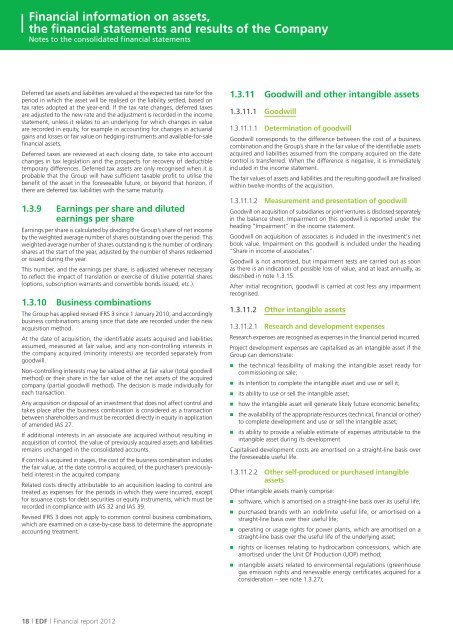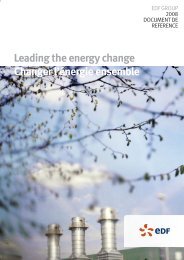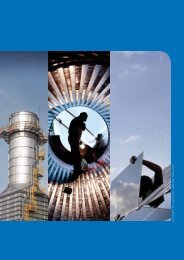PDF, 1.6 Mb - Shareholders and investors - EDF
PDF, 1.6 Mb - Shareholders and investors - EDF
PDF, 1.6 Mb - Shareholders and investors - EDF
You also want an ePaper? Increase the reach of your titles
YUMPU automatically turns print PDFs into web optimized ePapers that Google loves.
Financial information on assets,the financial statements <strong>and</strong> results of the CompanyNotes to the consolidated financial statementsDeferred tax assets <strong>and</strong> liabilities are valued at the expected tax rate for theperiod in which the asset will be realised or the liability settled, based ontax rates adopted at the year-end. If the tax rate changes, deferred taxesare adjusted to the new rate <strong>and</strong> the adjustment is recorded in the incomestatement, unless it relates to an underlying for which changes in valueare recorded in equity, for example in accounting for changes in actuarialgains <strong>and</strong> losses or fair value on hedging instruments <strong>and</strong> available-for-salefinancial assets.Deferred taxes are reviewed at each closing date, to take into accountchanges in tax legislation <strong>and</strong> the prospects for recovery of deductibletemporary differences. Deferred tax assets are only recognised when it isprobable that the Group will have sufficient taxable profit to utilise thebenefit of the asset in the foreseeable future, or beyond that horizon, ifthere are deferred tax liabilities with the same maturity.1.3.9 Earnings per share <strong>and</strong> dilutedearnings per shareEarnings per share is calculated by dividing the Group’s share of net incomeby the weighted average number of shares outst<strong>and</strong>ing over the period. Thisweighted average number of shares outst<strong>and</strong>ing is the number of ordinaryshares at the start of the year, adjusted by the number of shares redeemedor issued during the year.This number, <strong>and</strong> the earnings per share, is adjusted whenever necessaryto reflect the impact of translation or exercise of dilutive potential shares(options, subscription warrants <strong>and</strong> convertible bonds issued, etc.).1.3.10 Business combinationsThe Group has applied revised IFRS 3 since 1 January 2010, <strong>and</strong> accordinglybusiness combinations arising since that date are recorded under the newacquisition method.At the date of acquisition, the identifiable assets acquired <strong>and</strong> liabilitiesassumed, measured at fair value, <strong>and</strong> any non-controlling interests inthe company acquired (minority interests) are recorded separately fromgoodwill.Non-controlling interests may be valued either at fair value (total goodwillmethod) or their share in the fair value of the net assets of the acquiredcompany (partial goodwill method). The decision is made individually foreach transaction.Any acquisition or disposal of an investment that does not affect control <strong>and</strong>takes place after the business combination is considered as a transactionbetween shareholders <strong>and</strong> must be recorded directly in equity in applicationof amended IAS 27.If additional interests in an associate are acquired without resulting inacquisition of control, the value of previously acquired assets <strong>and</strong> liabilitiesremains unchanged in the consolidated accounts.If control is acquired in stages, the cost of the business combination includesthe fair value, at the date control is acquired, of the purchaser’s previouslyheldinterest in the acquired company.Related costs directly attributable to an acquisition leading to control aretreated as expenses for the periods in which they were incurred, exceptfor issuance costs for debt securities or equity instruments, which must berecorded in compliance with IAS 32 <strong>and</strong> IAS 39.Revised IFRS 3 does not apply to common control business combinations,which are examined on a case-by-case basis to determine the appropriateaccounting treatment.1.3.11 Goodwill <strong>and</strong> other intangible assets1.3.11.1 Goodwill1.3.11.1.1 Determination of goodwillGoodwill corresponds to the difference between the cost of a businesscombination <strong>and</strong> the Group’s share in the fair value of the identifiable assetsacquired <strong>and</strong> liabilities assumed from the company acquired on the datecontrol is transferred. When the difference is negative, it is immediatelyincluded in the income statement.The fair values of assets <strong>and</strong> liabilities <strong>and</strong> the resulting goodwill are finalisedwithin twelve months of the acquisition.1.3.11.1.2 Measurement <strong>and</strong> presentation of goodwillGoodwill on acquisition of subsidiaries or joint ventures is disclosed separatelyin the balance sheet. Impairment on this goodwill is reported under theheading “Impairment” in the income statement.Goodwill on acquisition of associates is included in the investment‘s netbook value. Impairment on this goodwill is included under the heading“Share in income of associates”.Goodwill is not amortised, but impairment tests are carried out as soonas there is an indication of possible loss of value, <strong>and</strong> at least annually, asdescribed in note 1.3.15.After initial recognition, goodwill is carried at cost less any impairmentrecognised.1.3.11.2 Other intangible assets1.3.11.2.1 Research <strong>and</strong> development expensesResearch expenses are recognised as expenses in the financial period incurred.Project development expenses are capitalised as an intangible asset if theGroup can demonstrate:• the technical feasibility of making the intangible asset ready forcommissioning or sale;• its intention to complete the intangible asset <strong>and</strong> use or sell it;• its ability to use or sell the intangible asset;• how the intangible asset will generate likely future economic benefits;• the availability of the appropriate resources (technical, financial or other)to complete development <strong>and</strong> use or sell the intangible asset;• its ability to provide a reliable estimate of expenses attributable to theintangible asset during its development.Capitalised development costs are amortised on a straight-line basis overthe foreseeable useful life.1.3.11.2.2 Other self-produced or purchased intangibleassetsOther intangible assets mainly comprise:• software, which is amortised on a straight-line basis over its useful life;• purchased br<strong>and</strong>s with an indefinite useful life, or amortised on astraight-line basis over their useful life;• operating or usage rights for power plants, which are amortised on astraight-line basis over the useful life of the underlying asset;• rights or licenses relating to hydrocarbon concessions, which areamortised under the Unit Of Production (UOP) method;• intangible assets related to environmental regulations (greenhousegas emission rights <strong>and</strong> renewable energy certificates acquired for aconsideration – see note 1.3.27);18 l <strong>EDF</strong> l Financial report 2012











